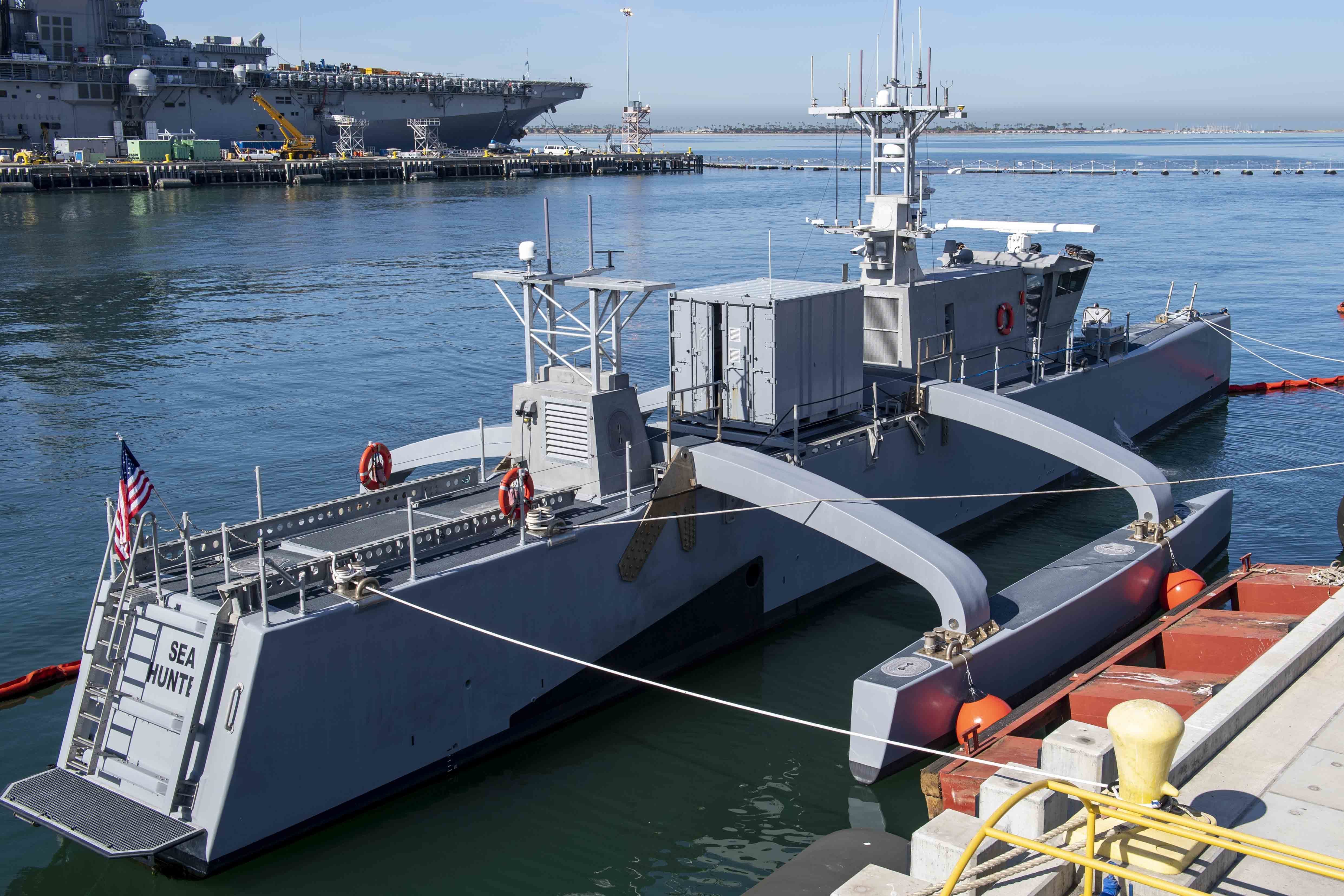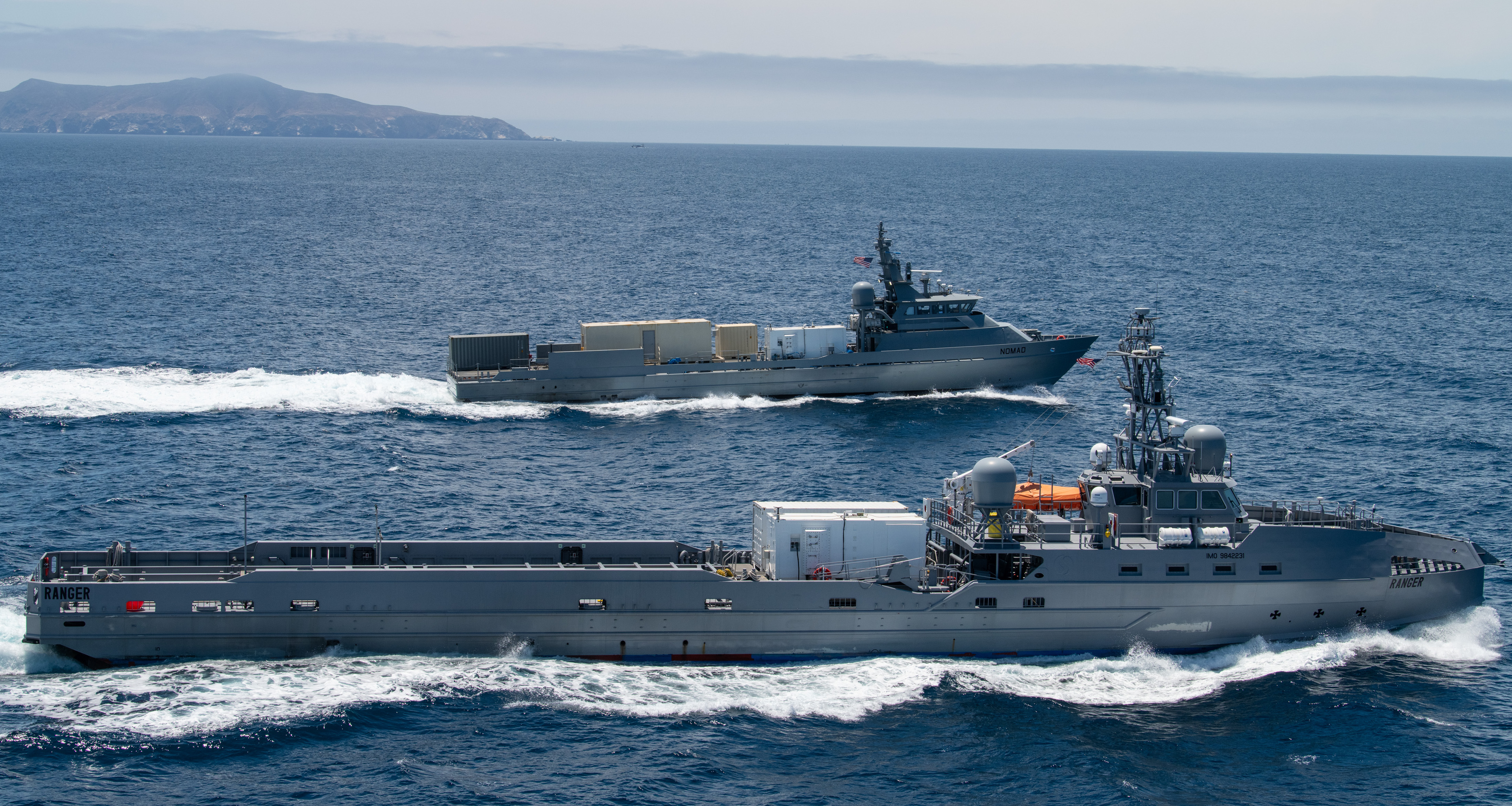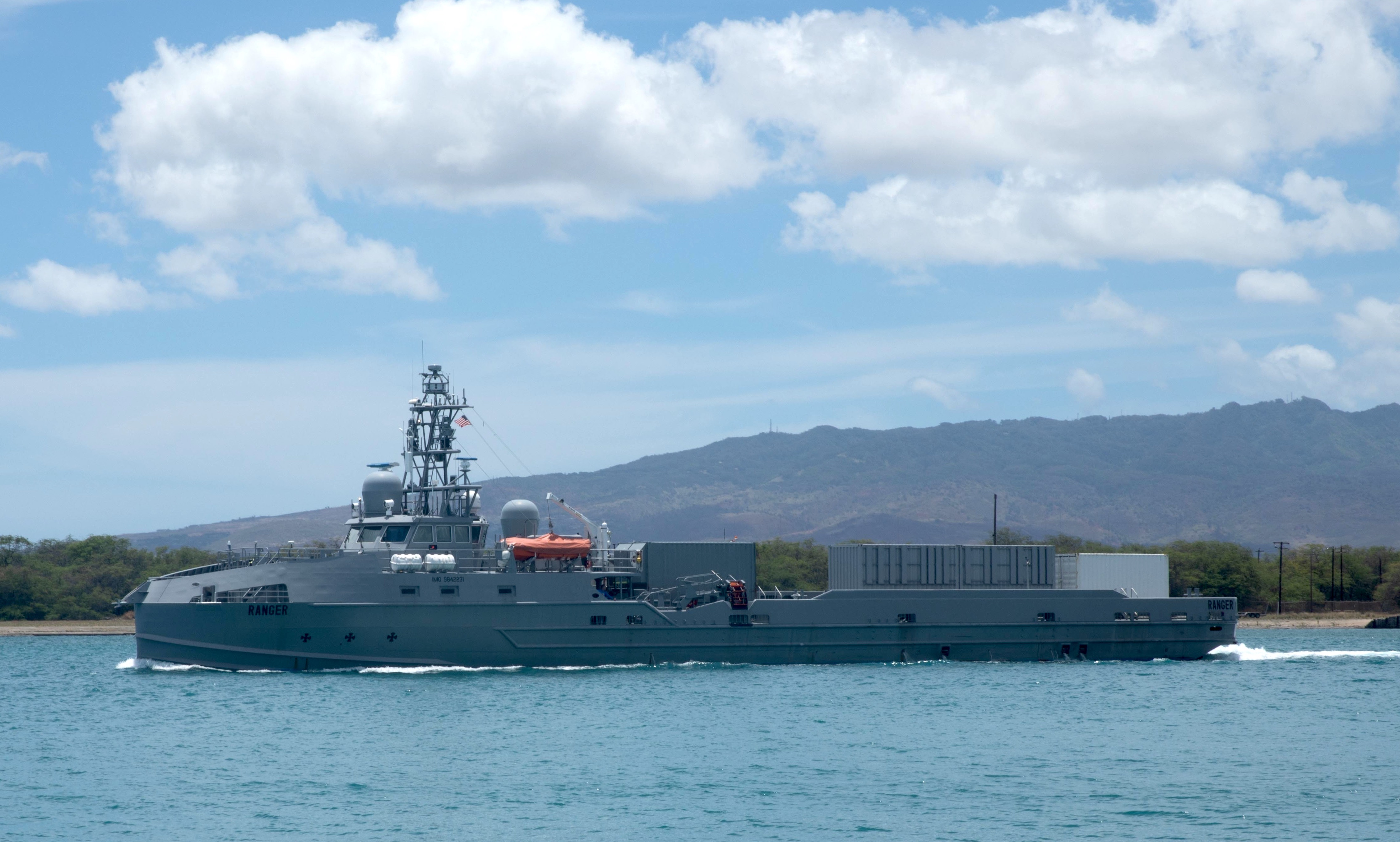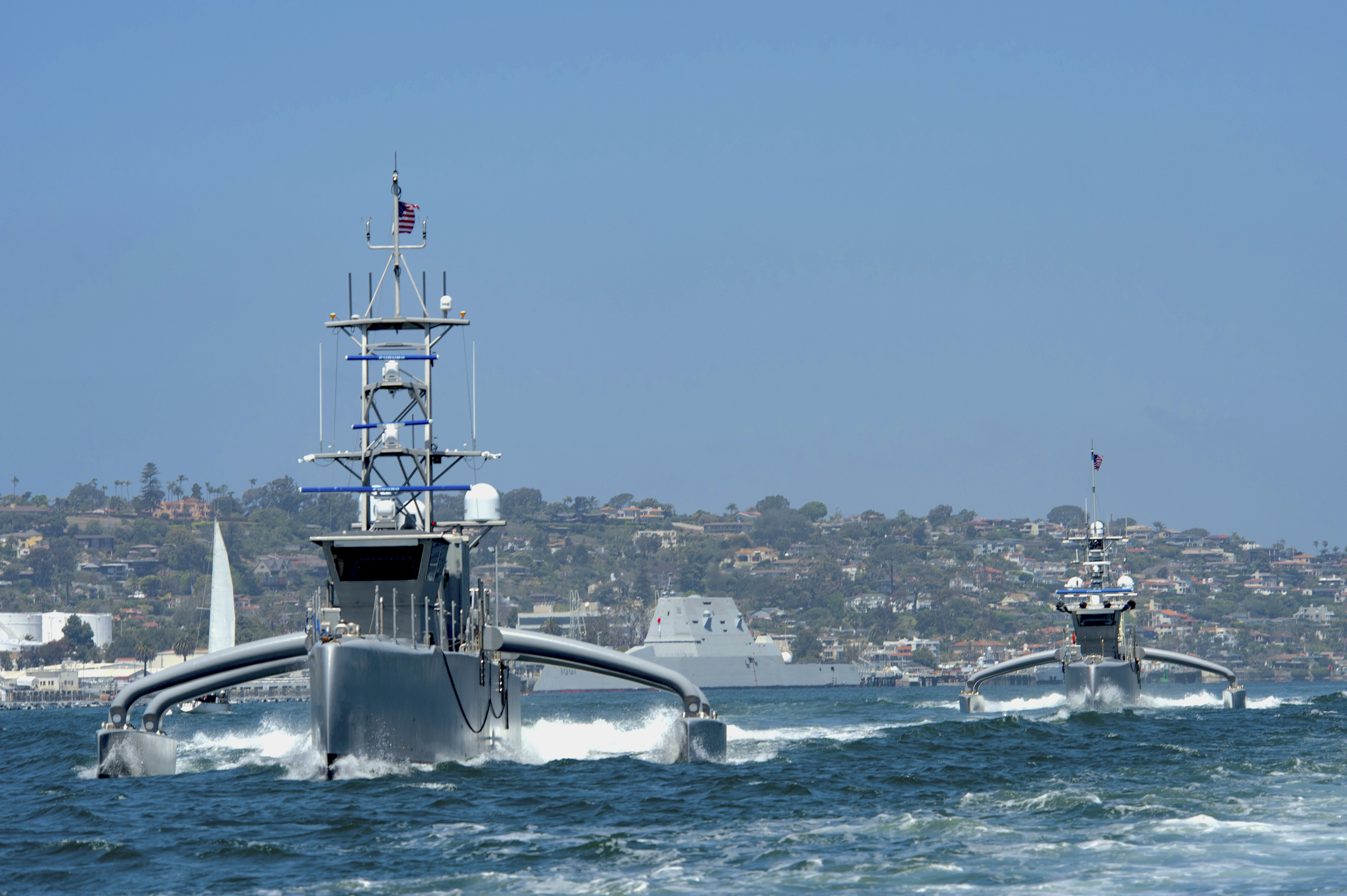
JOINT BASE PEARL HARBOR-HICKAM, HAWAII – A new California command for unmanned surface vessels will be the bridge between the Navy’s requirements team in Washington, D.C., and the operational fleet.
Cmdr. Jeremiah Daley, who leads the San Diego, Calif.,-based Unmanned Surface Vessel Division One, in a recent interview with USNI News described his new role as the “glue” between the program office at Naval Sea Systems Command and the fleet forward experimenting with the unmanned surface vehicles at sea.
The goal, Daley said, is to figure out what these USVs can do operationally to inform the evolving requirements for the Medium Unmanned Surface Vehicle (MUSV) and the Large Unmanned Surface Vehicle (LUSV).
“I have two overlapping bins – the first bin is the NAVSEA PMS 406 program office bin, which is to take a lot of lessons learned from this platform, which has been around for a few years and … the OSVs, and find out and develop both the autonomy and the ship systems to get to a program of record – LUSV, as an example … and what that looks like. And that’s a combination of … the autonomy and that sort of system for safe navigation of the vessels,” Daley told USNI News at the pier in Pearl Harbor, where USV Seahawk prepared to head out to sea for the biennial Rim of the Pacific 2022 exercise.
“And then there’s the payload piece, which is sort of the other bin. And that is not just a PMS 406 thing. That is an everyone contributing into the mix thing, into the team. And it’s bringing forward those capabilities, finding the right integration points to test them with the fleet, and to find the other testing and research opportunities to work through to figure out what the right blend of capability looks like for the program of record,” he continued.
Daley’s new USVDIV command now owns the Ghost Fleet Overlord test ships Nomad and Ranger, as well as Sea Hunter, which was originally developed by the Defense Advanced Research Projects Agency (DARPA), and its sister ship Seahawk.

Nomad and Ranger were originally developed by the Pentagon’s Strategic Capabilities Office, but were transferred over to the Navy for testing and experimentation. More ships are on the way.
Daley is charged with the at-sea experimentation portion meant to inform the requirements side for future USV programs of record. His command, which formally stood up in May, is responsible for “testing and developing not just the maturation of autonomy and how the ship drives, but also all of the associated payloads that the Navy in general is working towards in concert with our research partners towards making – finding the right payloads to put onto USVs and how we implement them for a future program of record,” he said.
While Nomad and Ranger have personnel aboard for RIMPAC, Sea Hunter and Seahawk are operating autonomously without anyone aboard, aside from a small crew that helps the two USVs leave the pier. The Navy plans to use these four USVs – all prototypes – to determine how best to employ the assets in the fleet, including how they can work with manned warships.
“The program office and NAVSEA are building the ship, but I am a fleet person. So my charter is to figure out how we’re going to use them in the fight and how we’re going to increase interoperability, distributed maritime operations and lethality for the combination of manned and unmanned, and how we do that,” Daley said.
At RIMPAC 2022, Daley and his team have the chance to pair the USVs with cruisers and destroyers to experiment with the manned-unmanned teaming concept that Navy officials say is critical to the future of the new technology. The idea is that the USVs can augment the manned ships with additional sensing capability or potentially weapons capacity.
While the Navy has employed the USVs in other exercises, the at-sea phase of RIMPAC is the first time the four platforms are participating in the same drills.

The Navy’s pursuit of unmanned USVs slowed in recent years amid Congressional skepticism over the new technology. Lawmakers wanted to see more testing and argued the Navy needs to better understand how it would employ the assets operationally, or the concept of operations.
“The perception may be from some that we’re running into this, this program’s been around for many years. The SCO – Ghost Fleet Overlord program – at least three years. My command just happens to be new,” Daley said. “But we’re at a level of evolution for how we are doing these types of testing events where you need a dedicated command that’s focused on bringing forward the technology, the lethality, the interconnectedness and finding out the right tactics, techniques and procedures – TTPs – on how we are going to interact and work with the fleet.”
Daley’s new command will help figures out the CONOPs and provide feedback to NAVSEA’s unmanned maritime systems program office, or PMS 406.
“PMS 406 and my organization are in constant contact with each other. We have a PMS 406 test director that is the gatekeeper for all events that we do for the underway periods on all of the vessels,” Daley told USNI News.
“So I am directly connected with them constantly, and my team and I are directly connected with them constantly so we can prioritize and work through and develop the plans on how we’re going to balance all the normal ship things – whether it’s maintenance or other things – and then how we’re going to do the testing and evaluating portion on both continuing the maturity of the autonomy and the sensor payload packages,” he added.
But Daley’s job also includes working toward the goals of the operational fleet commander.
Daley said sailors began pursuing the new command’s objectives earlier this year under the purview of Surface Development Squadron 1, which sits above Daley’s USVDIV One in the chain of command and was originally tasked with USV experimentation. That work leading up to USVDIV One’s formal stand-up in May included planning for RIMPAC.
“So my organization – we are planning just as if we were a regular Navy unit, just like a squadron of ships would have plans and operations departments. We have all the same infrastructure, so we utilized my boss’ staff to get ahead of that because we were brand new. We have the personnel in place to execute now and we will continue to grow as the next year or two go.”
Similar to manned ships, Daley has an operations center functioning like a battle watch 24 hours a day, seven days a week as the four USVs participate in RIMPAC.
“I also have an unmanned operations center that’s set up on the west coast of the U.S. that existed during the Ghost Fleet Overlord program as a test area. So I have the ability not just to be onboard, well stay onboard, but to control the vessels from ashore as well,” he said.

Also similar to manned ships, the Navy will need to determine how it will maintain and sustain the USVs. While the Navy owns the USVs, they are currently operated by a merchant marine company.
“The task that we have is that how do you turn that into the right blend of normal – like a destroyer does quarterly maintenance periods … how do you blend that and use those experiences from the traditional fleet to sort of what LCS has,” Daley said, referring to the Littoral Combat Ship, which has a contractor-centric maintenance model.
“We are taking all of the efficiencies and different types of ways to get after it from a maintenance and sustainability standpoint and how we apply that to unmanned platforms because it’s very different. I don’t have a sailor to go change a filter on an engine at 8 o’clock at night on a Tuesday. I have to come up with different hull, mechanical and electrical control systems, sensors and reliability on the engineering plan that can sustain operations for extended periods of time without having to have humans onboard,” he added, noting the efforts underway in Philadelphia to build a shore-based hull, mechanical and engineering prototype for the MUSV and LUSV programs.
With the four ships already under USVDIV’s purview and three more under construction – two optionally unmanned surface vessels like Nomad and Ranger and one MUSV prototype that L3 Technologies is building – for research and development, Daley said his team will participate in more exercises after RIMPAC to continue providing feedback from the operational side to the requirements side.
“We are no different from a regular ship that requires maintenance and other things. So we’re just not available all the time, just like a regular ship isn’t available all the time. So we will go back and we will collect the data and process that,” Daley said.
“But we have a structured plan on our testing objectives from the program office’s side, so we find those opportunities where we can accomplish both our own internal PMS 406 testing objectives and combine them with fleet events and exercises – fleet exercises – so that we can be as efficient as possible with our underway time.”





